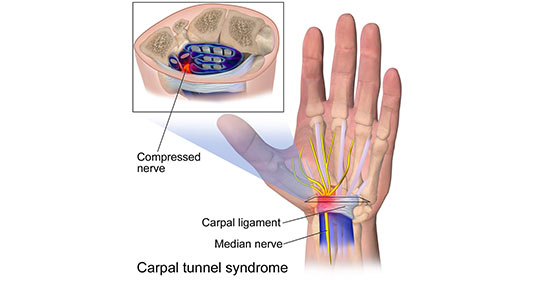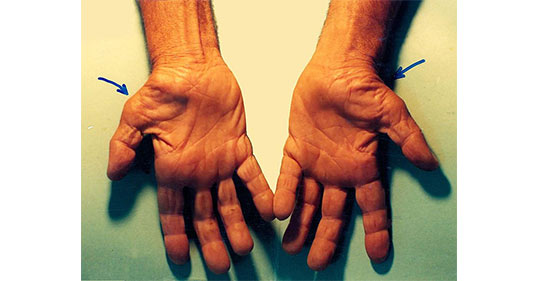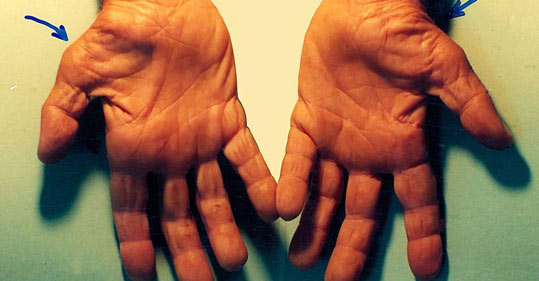Hands tired of excessive typing/texting? Try these quick stretches daily to relieve pain and avoid carpal tunnel syndrome
With so many of us increasingly spending most of our waking hours behind a computer, whatever the work may be, it’s often our hands and arms that bear the brunt of constant typing, with serious cases causing a distressing condition known as the Carpal Tunnel Syndrome (CTS). Find out how to avoid this condition and avoid overstressing your hands, wrists and arms with these very easy quick exercises.

What is carpal tunnel syndrome?
Full of nerve endings, our hands have a sophisticated channel of nerves that help us in carrying out finely coordinated hand and finger movements, like typing! The carpal tunnel is a narrow area located in your wrist from where these nerves enter your hand. However, this also means that constant pressure on your wrists can result in the compression of one of the major nerves to your hand that goes through it- the median nerve - causing pain, numbness, tingling in the fingers - a collection of symptoms together called the carpal tunnel syndrome - A condition as distressing as it sounds ! If left unchecked, the symptoms can worsen to cause weak grip strength, loss of sensation in the hands and eventually, muscle wastage.

How to prevent CTS?
The old saying ‘prevention is better than cure’ applies equally well to this situation. There are certain simple, quick exercises that one can do to prevent CTS . Trust us, you can do these in less than 5 minutes, while sitting on your office chair. Read on!
◠Median Nerve Glide Exercise: It’s much easier than it sounds, and is very effective in preventing CTS. Just follow these simple steps:
â—‹ Step 1: Raise your left arm sideways, at the same level as your face, your palm facing upwards, fingers stretched out, parallel to the ground, as if balancing a plate on your palm.
â—‹ Step 2: Clench your fingers into a fist, and release.
â—‹ Step 3: Now, with your palm still facing upwards, stretch your fingers and hand to point downwards. Hold this position.
â—‹ Step 4: Bring your thumb forward, away from the rest of your fingers. Rotate your palm to face you, and using your other hand, stretch your extended thumb out for two seconds.

â—‹ Repeat the above process with your right arm, and perform this cycle 4-5 times daily, and keep the muscle and nerve health of your hands intact.
â— Forearm Extensor Stretch: This exercise is excellent for pain that radiates down your arm and the elbow.
â—‹ Step 1: Raise your arm directly in front of you, hand stretched out, palm facing downwards, till about your shoulder height (Or as close to your shoulder height as your can comfortably raise).
â—‹ Step 2: Relax your wrist, letting it be limp, and with your other hand, gently apply pressure on the wrist, pushing it down towards the ground until you feel a gentle stretch. Hold this position for 30-40 seconds as you
○ Step 3: Repeat for the other arm, and perform it ever 2-3 hours, and take a water break too while you’re at it!
â— Rubber Band Finger Stretches:
â—‹ Step 1: Bring your fingertips close together, and fit an elastic band around them.
â—‹ Step 2: Stretch your fingers away from your thumb, and come back to the initial position. Repeat this expansion and contraction as many times as comfortable. Repeat the process for the other hand.
â—‹ Do make sure the elastic band is under tension the whole time you do this exercise, as that will ensure that your hand gets that stretch you need.
◠The Ayurvedic ‘Marma’ (Vital points) approach: In the Indian Ayurvedic system, ‘Marma’ are vital points in the body that are the junctions where bones, muscles and nerves meet. Applying gentle pressure and stimulation to these points can help stimulate blood flow and ease pain. Here are they key points on your hands and arms that often are victims of pain, and the quick exercises to heal the problems that ultimately affect the wrist, or the ‘Sandhimarma’:
â—‹ Wrist: Locate the center of your wrist, both on the outer and the inner side. Use your thumb and forefinger to clasp both these points and apply gentle pressure simultaneously for 2-3 minutes, very slowly increasing the pressure on both the points, however not causing pain. Deep breathing will help during this process. Repeat a few times daily.
â—‹ Outer elbow: Bend your elbow and, with the other hand, put your forefinger at the fleshy outer edge of where your elbow crease ends. Apply pressure to this point in a clockwise motion for a few minutes, all the while breathing deeply.
â—‹ Inner elbow: Extend your arm outwards and place a finger on the center of your elbow crease. Apply firm, continuous and deep pressure for at least two minutes, all the while breathing deeply. Repeat a few times daily for best results.
â—‹ Thumb (Kshipra marma): Point your thumb upwards facing you, and you will find this vital point on your palm, at the fleshy spot at base of your thumb. Press this point for up to one minute while breathing deeply.
Keep in mind to not overstretch during these exercises at any point, but just enough to feel the tension in the muscles before releasing. These simple but extremely effective exercises will keep your hands and arms happy and relaxed, keeping Carpal Tunnel Syndrome at bay. Do try these out and tell us your experience!










